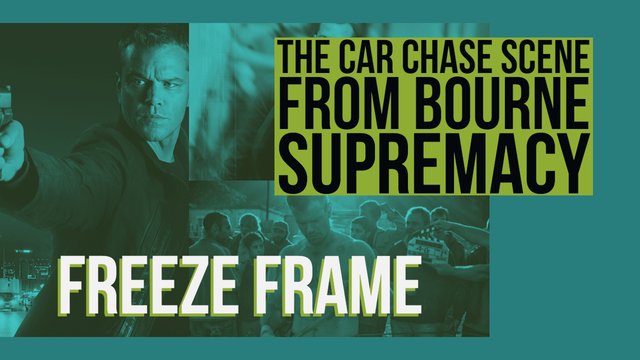Click to watch: https://www.youtube.com/watch?v=BZd6Urqx8jg
Howdy all, welcome to Freeze Frame, the show where we chase down tiny moments in film and "drive" our point home so recklessly someone's almost guaranteed to get hurt.
I'm Trendin Van Der Click, and if there's one type of scene in movies that's overplayed and overused, it's the good old fashioned car chase. From Bullitt to Ronin to The Matrix Relaoaded, car chase scenes have been a staple of the action movie since... well I guess since we had cars and movie cameras.
But with the advent of digital technology, CGI, and budgets higher than the GDP of an average third world country, the whole idea of a car chase started to feel a little underwhelming.
But there's one car chase scene that we here are Popcorn Lobotomy think stands out from the crowd and perhaps even single-handedly reinvigorated the entire car chase sub-genre.
Today let's talk about the car chase scene in The Bourne Supremacy.
Paul Greengrass was criticised heavily for his use of shaky-cam in the Bourne sequels -- and to some extent rightly so. As a lazy way to inject energy into a scene that would otherwise be lacklustre, it's a bit of a cheap trick.
But in Supremacy, it provided a visceral, personal and engaging experience, even if for an unfortunate few, that experience was vomiting up their KFC lunch into the toilet and missing the scene entirely!
So, why was the shakey-cam technique so successful in Supremacy, but when mimicked in subsequent films, it became confusing, annoying and occasionally nauseating?
Well, I reckon there are two elements that makes a great car chase scene -- and indeed a great fight scene -- and niether of them involve camera work or music or exotic locations; but rather a couple of things you might find a little unexpected:
Those two elements are strategy, and physics.
The best car chase scenes allow the audience to not just understand the action that's happening, but to follow the strategy that each participant is employing to outwit the other, and the physical forces they are exploiting in carrying out their strategy.
In Supremacy, the chase scene plays out like a classic fight scene.
The hero and the villain use their cars are weapons, engaging in a complex dance, staring each other down and jostling for position like a couple of medieval fencers.
But the struggle is presented as anything but elegant, as both participants grunt and sweat their way through it.
So by the time Jason Bourne shoots out his opponent's tyre and spins around 180 degrees to secure the dominant position, it's a relief to see the exhausting struggle finally coming to an end. It's a checkmate moment, and up until that point, you're probably not even aware their is a chess match going on!
I don't know about you, but when it dawned on me what was about to happen, it's like a moment of beautiful clarity amidst the chaos, and gave me a rush of adrenaline like no other.
All of a sudden the shaky-cam becomes unnoticeable. You're simply in the car with the protagonists, with sharp glass and heavy steel flying around you at all sides -- and that's exactly where Paul Greengrass wants you.
The camera stays close, focussing on the small details of the participants' interactions. Clarity is achieved by quick editing that gives you precise glimpses of each element you need to understand the complex machnisations of the unfolding battle.
You see a tyre explode, a hand shifting gears and tyres spinning against ashphalt, then that rare longer shot where the cars glide gracefully into position.
Bourne's car is now driving his opponent forward, and he's totally in control. The assassin realises that no amount of breaking or turning of the wheel is going to save him.
Bourne slams his foot on the accelerator, braces for impact and BOOM! Wow, what an impact! Both cars are wrecked beyond recognition and while Jason Bourne is badly hurt, he made sure the impact would hurt his adversary even worse.
Now you might be tempted to assume that Paul Greengrass shot this film in a haphazard run-and-gun style that mirrors the on-screen images, but from storyboards available online, it's clear that Greengrass meticulously planned each and every shot, just like most high budget Hollywood productions.
It is in the innovative shooting style that Greengrass created his truly unique experience, because he chose to shoot the film in a way that mimicks human sensory perception.
Think about it. The fast cuts, breif glimpses of action and blurred, unstable images are exactly how our eyes experience the world.
We don't see our environment all in one go. Our eyes dart around, targeting details our brains deem important, until we have enough information to stich the complete image together in our minds like a mosaic.
But here's the catch. For this technique to work, the editing choices need to closely match the points of interest your brain would naturally generate. If the images flashing across the screen lack detail, or do not follow a coherent chain of events, we cannot assemble the overall picture and we feel confused.
And that's what happened -- and continues to happen -- with a lot of action movies that attempt to mimick Greengrass's style. They just don't have the pre-planning and precise editing skills to pull it off, leaving us with confounding, jumbled scenes that obfuscate the action instead of enhancing it.
So I'm with the rest of you. Down with shaky-cam! Unless it's in the hands of Paul Greengrass, in which case, hell yeah, bring it on!
Say what you will, but the techniques employed in Bourne Supremacy changed action films for decades to follow, and we're still feeling the repercussions of it today.
Watch the scene:

Downvoting a post can decrease pending rewards and make it less visible. Common reasons:
Submit